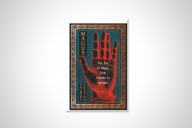You have /5 articles left.
Sign up for a free account or log in.
The contributor’s note to one of Mikita Brottman’s journal articles gives her institutional affiliation with the Maryland Institute College of Art in Baltimore, where she is a professor of humanistic studies, and then sums up a striking aspect of her work in a single sentence: "She writes frequently for scholarly, mainstream and underground publications." Besides a number books in film studies, she has published works on psychoanalysis (which she also practices) and animals (dogs and hyenas, one volume each) as well as writing the first monograph on Gershon Legman, an outsider scholar who collected and analyzed sexual folklore.
Combining literary criticism with penology, Brottman’s The Maximum Security Book Club: Reading Literature in a Men’s Prison also contains a certain amount of autobiography: "My writing, research, relationships and teaching have always been part of the same stream of experience. Imposing boundaries on this kind of life -- classifying some relationships as personal and others professional -- has always been impossible for me." Most of Brottman’s work bears the imprint of a scholarly or commercial press, but a few of her books are from marginal publishers, small editions that instantly became collector’s items. Farsighted research librarians finding some Brottman titles in their stacks might well want to consider whether they ought to transferred to the rare books room.
Her latest, Couple Found Slain: After a Family Murder (Henry Holt and Company), sounds like just one more book in the true crime genre. Take out the colon between the title and subtitle and you have a commonplace newspaper headline. When such stories are turned into books -- or podcasts or documentaries -- the template is pretty standard. Biographical sketches of the victims, perpetrator(s) and investigators are organized around a reconstruction of what happened, as often as not padded with descriptive boilerplate about the area, including major tourist destinations and the region’s economy. More or less drawn-out forensic and judicial operations lead to verdict and sentence. The continuing impact of the murder trial may be considered in a postscript. (I say "murder," because that is almost always the offense in question. True crime books about notorious purse snatchers or carjacking rings are few and far between.) Narrative closure is a priority in the true crime genre: the reader expects to return to ordinary life with some sense of order having been restored.
As it happens, I live close enough to where the crime at the center of Brottman’s new book took place to have read about the case at the time. Brian Bechtold shot his parents in suburban Maryland in early 1992 and was -- as I also dimly recall -- found not criminally responsible a few months later. The bodies were only discovered when Bechtold turned himself in to police in Florida, two weeks after the shooting, explaining that he had been possessed by the devil. (Evidently, he came across as someone who might believe such a thing, since the police in Florida pushed Bechtold to consider the possibility he had perhaps hallucinated the killings.)
Brottman’s account of the Bechtold household and the crime itself takes up only about a quarter of the book, narrated in a style too terse ever to be lurid. The family dynamics were poisonous enough: the father was distant and cold on a good day, brutal on a bad one; the mother was inclined to mood swings and learned helplessness; and at least one of Brian’s sisters made repeated attempts at suicide. Such relationships do not make slaughter the only way out, of course, but things go that way commonly enough:
"In the United States alone," writes Brottman, "there are at least three hundred cases of parricide every year … Typically, the perpetrator is a male in his late teens or early twenties, is from a white middle-class family, and may be acting out the unconscious wishes of his siblings or, in cases where only one parent is killed, of the surviving parent. Most are of above-average intelligence. They tend to be isolated, without many friends, and the typical weapon is a gun kept in the home."
Brian Bechtold checks most of the boxes -- and more as well. Most perpetrators "are isolated from other individuals and have few, if any, friends. There’s usually a history of alcoholism or drug abuse in the family, and in most cases, the victims’ deaths come as a relief to the perpetrator, at least initially … In most cases, when the murder occurs, the perpetrator reports being in a dissociative state; afterward, if they can remember the crime at all, it seems unreal, dreamlike or vague, as though it happened to someone else." A diagnosis of schizophrenia is common. "In fact," the author notes, “the two are so intertwined that parricide used to be known as ‘the schizophrenic crime’” -- an unfortunate turn of phrase, since most people diagnosed with schizophrenia are not violent.
As true crime stories go, the Bechtold case seems remarkably free of suspense. It is the worst possible outcome of lives of quiet desperation. If there is any element of surprise in Couple Found Slain: After a Family Murder, it comes from the huge shift of emphasis signaled by that colon in its title. Most of the narrative concerns Brian Bechtold’s life after the murder of his parents, during the years he’s spent in a maximum-security psychiatric hospital in Maryland. Brottman got to know him while teaching a course called Focus on Fiction, similar to the one in a men’s prison recounted in The Maximum Security Book Club.
In principle, those in the psychiatric hospital are patients, not convicts, sent there for observation and treatment, not punishment, with the possibility of a supervised transition to the outside world if they show improvement. And indeed, any number of people who committed crimes as heinous as parricide -- or, in some cases, worse -- have entered the hospital after Bechtold was sent there and made their way back to whatever is left of their lives. He, however, has remained in limbo there for almost 30 years.
The author chronicles a succession of administrative regimes, some more reliant than others on medicating the patients into a vegetative state, and her examination of Bechtold’s records suggest that evaluations of his condition have been inconsistent if not arbitrary. ("Whatever may be wrong with him now," Brottman says, "it doesn’t seem to be any of the five different personality disorders he’s been diagnosed with over the last three decades.") One of Bechtold’s psychiatrists was eventually placed under treatment at another institution for stalking a public figure -- to the surprise of his colleagues, though not, it seems, to his patients.
Much of the book is harrowing and, suitably enough, depressing. True crime afficionados usually find themselves identifying with one figure or another in the narrative -- with Truman Capote’s In Cold Blood as the rare case where imaginative sympathy is possible for the victims, the perpetrators and the police, and for the judge, jury and executioner as well. Couple Found Slain dismantles the genre’s narrative machinery. Bechtold emerges as a complex and sympathetic yet, even now, sometimes frightening figure. He did try to escape a couple of times. But it bears mentioning that his hope was either to be given a regular prison sentence or to commit suicide by cop. The reader is in no position to judge his condition, but the situation he’s ended up in is, indeed, insane.








